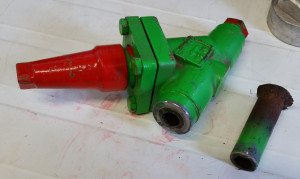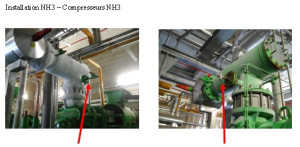An ammonia leak occurred in an industrial bakery at 8:50 p.m. in the equipment room containing an NH3/CO2 cascade refrigeration system. The leak occurred when a DN15 branch connection failed on a valve configured for maintenance work on the gas intake line of one of the 3 ammonia system compressors; 200 kg of ammonia was released. The safety devices were activated (the threshold of 1,000 ppm had been reached), causing the electrical power in the equipment room to be shut off and the safety extractor to be switched on. The 70 employees were evacuated around 9:00 p.m. The manual valves were then closed at around 10:15 p.m. which stopped the leak. The firefighters were on site at 10:30 p.m.. 2 employees feeling ill transported to the hospital for observation. The premises were ventilated.
The waste generated by the production shutdown was removed, and the area cleaned. The line was restarted only 20 hours later.
Based on the operator’s causal analysis, the weight of the service valve may have created stress, resulting in the clean break observed on the threads. In addition, there was no supporting element on either side of the valve and the branch connection was probably too long, with no support at the end. The valve was found on the ground.
A multi-spectral vibration analysis (on the only compressor in the installation with speed variations) did not confirm this cause. However, the overhaul of the compressor conducted in 2015 required handling operations that may have had an impact on the installation. There may not have been a thorough visual inspection after the intervention.
The valve was replaced the following day by the company in charge of the site’s refrigeration installations. The valve type was modified to reduce stress (shortening the branch connection and installation of a lighter cross valve). As a preventive measure, the operator ordered the replacement of the valves on five other identical nozzles on site with lighter ones and also shortened the connections.





